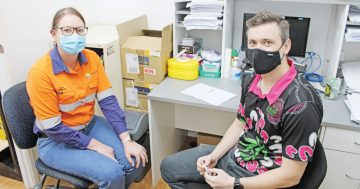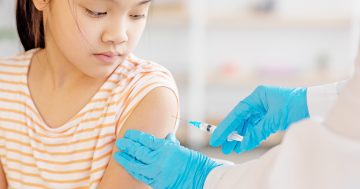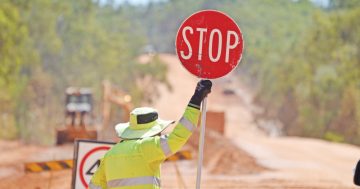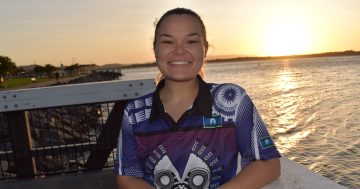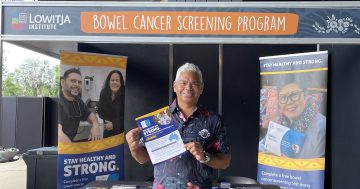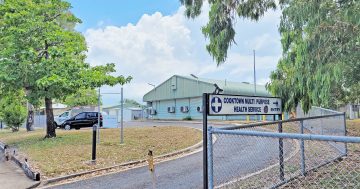
Cape York was rocked over the Christmas period when the first cases of COVID-19 were reported in the community. The chief executive of the Torres and Cape Hospital and Health Service BEV HAMERTON last week gave half an hour of her time to Cape York Weekly editor MATT NICHOLLS to discuss the challenges …
MN: The health service had no cases of COVID up until a couple of weeks ago with the Omicron variant. Do you feel like that clear run is now giving you an advantage?
BH: I definitely do. We’ve got vaccination rates up above 80 per cent in a lot of communities now and above 70 per cent in a great group of communities.
And then we’ve got a few that are worrisome. We will concentrate our efforts on those few that are worrisome very early in the new year, as well as starting the vaccines for those aged 5 to 11.
So vaccinations in terms of dose one, dose two, and dose three, are going to be a real focus for us, and then we’ll start those children’s vaccines as well.
The other thing is we’ve got is really good, well thought out, rapid response plans in place.
And having had 100 COVID presentations, we’ve had the opportunity to do early testing of those rapid response plans.
And they’re working. So you’re pleased about that.
We’re also pleased with the relationship that we’ve developed with the mayors and the council chief executives who represent their communities on the local disaster management groups.
We meet with them weekly and have been doing for months. And we have established good working communication and a good relationship about how we’re all in this together.
They have come forward and offered us assistance in the social sense of looking after people when you’ve got COVID in community so, yes, only eight days in from our first case, but we’re pleased with how things are going.
Now that Omicron has arrived in the Torres and Cape, you can start making projections about the spread of the virus.What should the public expect in the coming weeks and months?
I think that if you look at NSW, Victoria and south-east Queensland over the last couple of weeks, you will see that isolation has not worked in slowing the spread of Omicron.
So I think that we need to recognise that most people are going to get an Omicron infection at some point in the next few months.
Given we started on December 28, we’re looking at our peak to be possibly in February, maybe in the first couple of weeks of March.
If you go on what the world is doing, you see that the peak arises rapidly and then falls rapidly because you’ve got good community immunity – herd immunity – plus the vaccine.

That projected peak will tie in with school going back, which I’m sure is a challenge in itself. You mentioned the ages 5 to 11 before – they are currently unvaccinated against COVID?
That’s right. So we were able to do the 12 to 16 age group last year and we’ve done well with our vaccination rates in each community.
The permission (for 5 to 11s) came through from the TGA just before Christmas.
Queensland’s effort at vaccinating 5 to 11s with pediatric doses will start on January 10, and we will as well.
Will that be done through the schools?
Yes and no. We’ll try and get as many vaccinated before school returns.
We are working closely with Apunipima and the RFDS. They’ll be helping us make sure that we’ve covered as many kids as we can. They need parental consent.
I just want to change slightly off-topic to the actual cases. As we speak, there are 108 active cases. How many of those do we think are from community transmission in the region?
At the moment they are mostly from arrivals. But we are starting to see community transmission, mostly in the hub sites of Weipa, Bamaga and Cooktown.
And then there are the cases in Lakeland.
I don’t want to name any properties, but it’s quite obvious from the numbers that Lakeland is a farm case. I’ve been told those who are infected are isolated from the community. Is that fair to say?
We’ve been working with the farm managers out there around the public health processes that need to be put in place for those workers who are working.
We’ve had very good cooperation from the farm managers.
There is no health clinic at Lakeland, how are those farm workers being tested?
I think four people went to Cooktown to get tested.
Once we knew about the confirmed cases, we kept them on the property and started sending health teams out there to do testing, keeping them on the property.
You have major health centres on Thursday Island, in Bamaga, Weipa and Cooktown, but you also have health clinics in just about every community. What sort of pressure has there been on the health service, not just in the last couple of weeks but in the past couple of years?
It’s been a constant battle to get the right amount of staff into each clinic consistently.
We have ups and downs where we’ve got good staffing levels everywhere and then, five minutes later, you’ve got an a number of people who have finished their contract or leaving or whatever else. So it’s been swings and roundabouts.
There has been a shortage of staff all over Australia because people normally would come from New Zealand and from other places to work.
Obviously staff are taking all precautions by wearing full PPE and things like that. But it seems inevitable that there will be staff that catch Omicron because it’s so contagious. How is the health service trying to manage the operations of the services?
We’ve got a whole workforce plan that says that when we get positive cases in more than one community, we stand down what we consider non-essential services.
In this period, over the next eight weeks, where we think that we will reach our peak, we will convert all of our specialist clinics to telehealth.
We have a vulnerable patient plan in place where Apunipima, RFDS and our doctors and nurses are touching base with the vulnerable patient groups.

I know a lot of the hospital workers at Weipa and a few at the other communities and I know they have working hard to keep the community safe. You must be proud of them?
I honestly can’t speak highly enough of them.
For the last two years it’s been a roller coaster ride.
Each and every time they have responded when things change.
What we’re doing happens minute to minute at the moment. They just turn around and go: ‘OK, so that was that yesterday and this today’.
They’ve been flexible, they’ve been resilient, they’ve been robust.
We know that they’re tired so we have put in place some things to manage that.
We’re working with our leaders to make sure that everybody gets the right amount of break and has time away from phones and away from work.
We’re working I’m really hard on that.
The planning and the thinking and the problem solving that has gone into this is second to none.
One of the challenges the Torres and Cape has is our large Indigenous population. We know that housing density is an issue in communities. Let’s say, for example, someone from Napranum gets COVID and they need to isolate at home, but their house has got eight people living in it. What would be the plan?
We’ve been working with the local councils and disaster management groups for the last few months on getting an isolation accommodation plan together.
We now have a list of available accommodation that can be converted into an area for a family or for a single person.
In some cases, where we’ve got more than one family member infected, they can stay together and they can look after themselves.
We’ve also worked with the local supermarkets and stores to put together family food packages and have them delivered.
We also have some accommodation options in Cairns, for those cases where we can’t find a solution in the local community.
Back onto direct healthcare and one of the challenges Australia has is getting access to RATs (rapid antigen tests). How are we faring in the Cape and Torres Strait?
So we only started to get a supply of RATs about three or four days ago.
The ones that we have at Queensland Health are multi-vial RATs, to be administered by health staff. Those will be our first point of call.
So if someone presents with symptoms, we will test them with a RAT, which is something we had already begun to do.
Once you test positive to a RAT you won’t necessarily get a PCR test you will just assume you have got COVID and you’ve got to go home and isolate.
We’ll give you a list of things to watch out for, a contact list if you’re not feeling well or you’re feeling anxious about your mental health etc.
I know you’re not a doctor but if you get COVID and you’re at home, what should you be doing to get better?
It’s a similar recovery to the flu in that you need to rest, stay well hydrated and use simple pain relief, like Panadol and Nurofen.
But you need to watch yourself for worsening signs and symptoms. Most of the patients who need further treatment start to get a high pulse rate and shortness of breath.
So we’re watching out for those symptoms.
Is the health service keeping an eye on our COVID patients?
At the moment, all of our patients are in virtual care.
Positive cases get two phone calls a day to check on their health and close contacts get one phone call a day to check on their health.
So those 100 cases that we’ve got are contacted every day.
We’re in a tricky position where we have the combination of treating cases, the need to vaccinate 5 to 11-year-olds, plus give boosters to those who have been double-dosed. There are also people now wanting to get vaccinated for the first time now that we have cases. What is the plan for the next couple of weeks?
We offered vaccinations at the hub sites over the Christmas-New Year period and I think we administered about 500 jabs in that time.
Interestingly enough, about a third of those were first doses, so people are starting to think, ‘wow, you know, it’s time to stop hesitating and start getting vaccinated’, which is really good.
This week, we have vaccination centres in the hub sites, and a lot of places now have trained staff and vaccines available in communities so that you can go and get them at the local clinic.
We’re ramping up our vaccination teams to do visits, particularly in the communities with low second dose rates.
Going forward we really want to get 95-plus per cent of Cape and Torres Strait people double vaccinated and boosted, if possible.
It’s an ambitious target but the best way to prevent people from getting really sick from COVID is to get them vaccinated.

